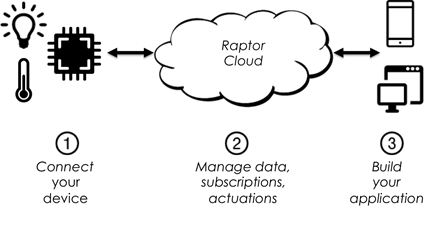Assets

Raptorbox is a smart IoT Brokering software platform for rapid prototyping Internet of Things Applications.
It is composed of a set of Restful HTTP APIs and an MQTT broker to create a reactive stream of data and action triggers for your devices. Its GUI enables users with better management and complete view of your devices with the data.
Raptorbox is equipped with a visual workflow editor to enable rapid configuration of decision logic based on data and effective actions on devices.
Here follows a summary description of Raptorbox platform.
For more information please refer to Raptorbox documentation.
Platform overview
Raptor is a platform offering a set of tools to easily and quickly connect your devices, making data they generate accessible from the cloud and offering mechanisms to interact with them remotely in order to build your connected solutions and applications.

Raptor offers specific tools to:
- configure devices allowing communication and interaction with Raptor cloud services in a secure way
- manage data flows produced by devices and handle data storage, allow applications to subscribe for notifications about data changes and offer capabilities to perform actuation on your devices
- build & deploy rapidly applications enjoying rich tools, open restful APIs and libraries aiming at simplifying the way in which you build your next IoT application
Data model
Raptor uses a well-defined data model to define a device and all of its possible interactions.
Using a generic abstraction allow for flexible deployment and device capabilities description yet flexibility over its interaction with the application logic.
A device is composed of streams, actions and optional properties.
Streams are datasets, you can imagine them as tables. A channel stay in a stream and is the minimum information to give meaning to the data. Imagine to a channel as a column of our table.
Actions are operation a device can perform on request. Raptor has a mechanism to trigger such operation thanks to a dedicate API and a structured two-way communication between the cloud and the device
The model support also properties, used as a registry by integrated application to match and lookup external metadata (like ID, version or unique codes) stored in third party systems
Security Aspects
Raptor supports user login and token-based authentication in order to handle authentication and authorization to access and use the Raptor APIs.
Users can get credentials for the various entities needing to access specific platform capabilities via the Raptor API: credentials are in the form of access tokens, called API Keys, that can be generated and obtained though Raptor user interface.
The following picture explains relationships among users, devices and API keys handled by Raptor.

API keys can have permission and also delegation privileges, making them the perfect choice for integrated applications required to manage not only many devices but also to track the ownership of those devices to different users.
Software and Documentation
The open source version of Raptorbox is available on GitHub, where you can have access to source code and instructions to install and test it (documentation here)
For more information please refer to OpenIot Unit.